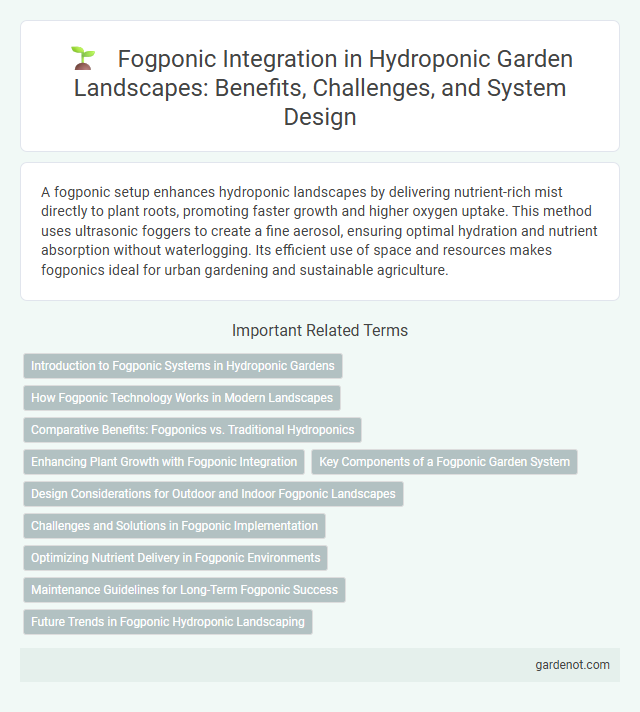A fogponic setup enhances hydroponic landscapes by delivering nutrient-rich mist directly to plant roots, promoting faster growth and higher oxygen uptake. This method uses ultrasonic foggers to create a fine aerosol, ensuring optimal hydration and nutrient absorption without waterlogging. Its efficient use of space and resources makes fogponics ideal for urban gardening and sustainable agriculture.
Introduction to Fogponic Systems in Hydroponic Gardens
Fogponic systems in hydroponic gardens utilize a nutrient-rich mist to deliver essential water and minerals directly to plant roots, enhancing oxygen availability and nutrient absorption efficiency. This method supports rapid plant growth and reduces water usage compared to traditional hydroponics by creating a fine fog that maximizes root exposure to nutrients. Key components of fogponic setups include ultrasonic humidifiers or foggers, a closed root chamber, and a recirculation system to maintain optimal nutrient and moisture levels.
How Fogponic Technology Works in Modern Landscapes
Fogponic technology in modern landscapes utilizes ultrasonic nebulizers to create a fine mist of nutrient-rich water that directly envelopes plant roots, enhancing oxygenation and nutrient absorption. This setup allows precise control over humidity and nutrient delivery, promoting faster growth and healthier plants compared to traditional methods. Integrating sensors and automated systems further optimizes fog distribution, making fogponics a highly efficient solution for sustainable urban gardening and innovative green spaces.
Comparative Benefits: Fogponics vs. Traditional Hydroponics
Fogponic setups utilize ultra-fine nutrient mist to deliver oxygen and nutrients directly to plant roots, enhancing oxygen availability compared to traditional hydroponics, which submerge roots in nutrient-rich water. This improved oxygenation promotes faster growth rates and higher nutrient absorption efficiency in fogponic systems. Additionally, fogponics significantly reduces water usage and minimizes the risk of root diseases due to the absence of standing water.
Enhancing Plant Growth with Fogponic Integration
Fogponic integration enhances plant growth by delivering nutrient-rich fog directly to the root zone, improving oxygen availability and nutrient absorption efficiency. This method promotes faster development and higher yields compared to traditional hydroponic systems by maintaining optimal moisture and reducing root diseases. Advanced fogponic setups use ultrasonic misters to create a fine nutrient mist, ensuring uniform distribution and maximizing plant health in controlled environments.
Key Components of a Fogponic Garden System
Key components of a fogponic garden system include ultrasonic foggers that generate nutrient-rich mist, a sealed growth chamber to maintain optimal humidity and temperature, and a robust nutrient reservoir ensuring consistent delivery of essential minerals. Air pumps and humidity sensors regulate oxygen levels and moisture concentration, promoting healthy root development and preventing root rot. Precision control units integrate these elements, optimizing plant growth efficiency in fogponic hydroponic landscapes.
Design Considerations for Outdoor and Indoor Fogponic Landscapes
Fogponic setups require precise control of humidity, temperature, and nutrient mist particle size to optimize root absorption in both indoor and outdoor landscapes. Outdoor fogponic systems must incorporate UV-resistant materials and weatherproofing to withstand environmental fluctuations, while indoor setups benefit from controlled lighting and ventilation to maintain consistent microclimates. Effective fogger placement and fog chamber design ensure uniform nutrient distribution and prevent root desiccation, maximizing plant growth and health.
Challenges and Solutions in Fogponic Implementation
Fogponic systems face challenges such as maintaining consistent fog droplet size and nutrient delivery to roots, which are critical for optimal plant growth and preventing root damage. Solutions include using ultrasonic foggers with adjustable frequency settings to control droplet size and implementing automated nutrient monitoring systems to ensure precise nutrient concentration levels. Regular equipment maintenance and real-time environmental sensors help prevent clogging and system failures in fogponic setups.
Optimizing Nutrient Delivery in Fogponic Environments
Fogponic systems optimize nutrient delivery by using ultra-fine nutrient-rich mist to ensure maximum root absorption and oxygen availability, enhancing plant growth efficiency. Precise control of mist particle size and nutrient concentration is critical to prevent root damage and optimize uptake rates. Integrating automated sensors and timers improves nutrient distribution consistency, reducing waste and promoting healthier root development in hydroponic landscapes.
Maintenance Guidelines for Long-Term Fogponic Success
Regularly inspect fogger nozzles to prevent clogging and ensure consistent mist output, which is critical for nutrient delivery and root oxygenation in fogponic systems. Maintain optimal water quality by monitoring pH and nutrient concentration, adjusting as needed to support healthy plant growth and prevent microbial buildup. Implement routine cleaning and sterilization of the reservoir and fogger components to minimize disease risk and sustain efficient system performance over time.
Future Trends in Fogponic Hydroponic Landscaping
Future trends in fogponic hydroponic landscaping emphasize increased automation and AI-driven climate control to optimize nutrient mist delivery and plant growth cycles. Integration of renewable energy sources like solar panels enhances sustainability by reducing the carbon footprint of fogponic systems. Advanced sensor networks enable real-time monitoring of humidity, temperature, and nutrient concentration, facilitating precision agriculture in urban environments.
Fogponic setup Infographic

 gardenot.com
gardenot.com